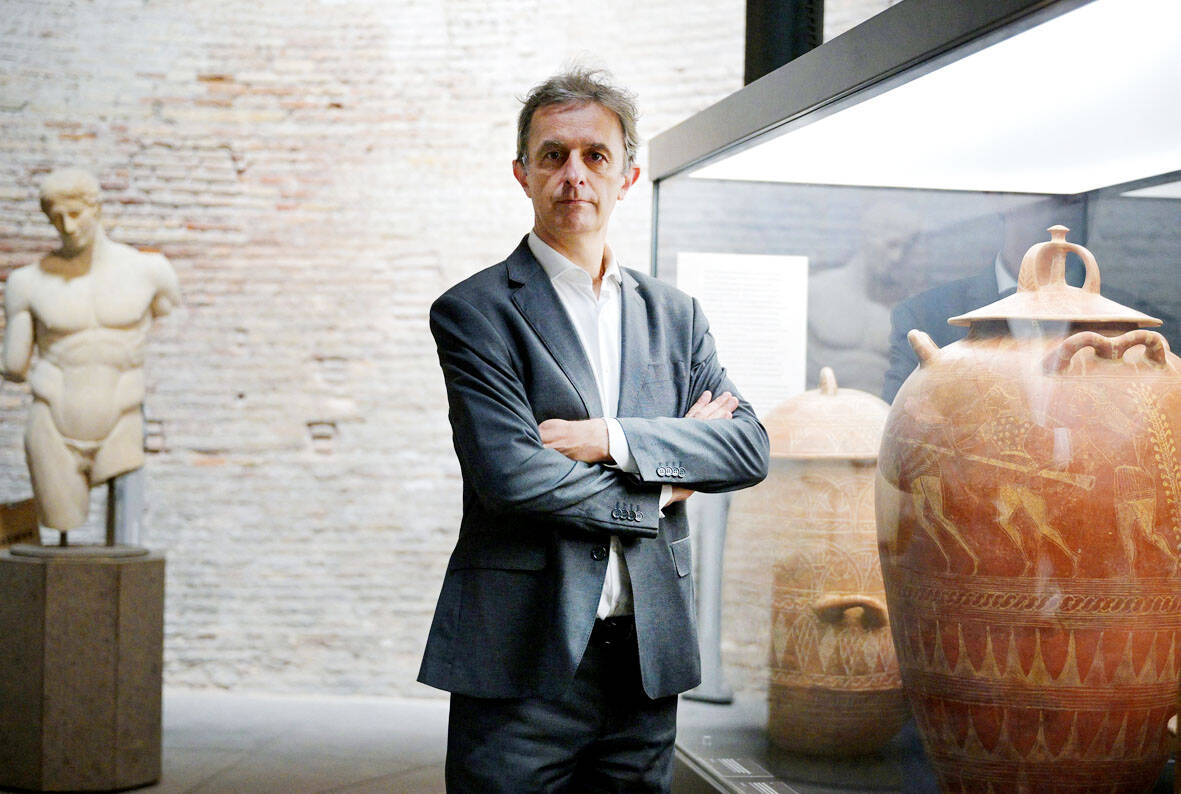Antiquities recovered after being looted in Italy and sold on the global black market have found their sanctuary in the heart of Rome.
The “Museum for Rescued Art” is housed in a spectacular hall within the majestic Diocletian Baths, ancient Rome’s largest bath complex.
Currently holding dozens of amphorae, coins and busts, the museum stages rotating exhibits aimed not just at showcasing the art, but recounting how it was rescued.

Photo: AFP
Some of the antiquities were looted during illegal excavations of Etruscan necropolises north of Rome or from secret digs in the southern region of Puglia.
Many were smuggled out of Italy via a network of antique dealers and sold to foreign collectors.
Some of the objects highlighted were “resold or donated to major American museums” in the past, said museum director Stephane Verger, a French archaeologist.
Italy has waged legal and diplomatic battles lasting years as it seeks to recover its stolen artworks and plundered archaeological artefacts.
Two years ago it scored a major success.
The prestigious Getty Museum in Los Angeles agreed to return to Italy a group of three life-size terracotta statues known as Orpheus and the Sirens dating from the fourth century BC, acknowledging they had been illegally excavated. They, too, made their way to the Museum for Rescued Art, part of a thematic exhibit on Italian terracotta. “We don’t want to be like those big museums and simply show beautiful works,” Verger said.
“It is an educational museum which shows all the dangers of international trafficking.”
But the works do not stay here.
“After being exhibited for some time, they are repatriated to other Italian museums,” Verger said — precisely where they should have been all along had they not been smuggled out of the country.
GRAVE ROBBERS
Illegal excavations, such as when ancient burial sites are targeted by tombaroli, or grave robbers, are damaging in two key ways.
Archaeologists are deprived of the looted objects themselves, but also key information on how, where and when they were found.
“Clandestine excavations have a very negative impact on our knowledge of ancient cultures,” Verger said.
The museum, which opened two years ago, is temporarily closed due to construction works ahead of the 2025 Jubilee Year, in which millions of Catholic pilgrims are expected to visit Rome.
But when it re-opens, could it welcome The Athlete of Fano, a splendid ancient Greek statue in bronze that has been at the Getty for nearly 50 years? The European Court of Human Rights ruled earlier this month in favor of Italy’s request to take back the statue, known in the US as Victorious Youth.
But Getty contests the decision and the case could be referred to the court’s Grand Chamber for further examination.
Discovered 60 years ago by Italian fishermen off the Adriatic coast of Fano in central Italy, the statue is believed to have been immediately sold, changing hands several times before resurfacing on the art market in 1974.
The statue, which depicts a nude athlete with a wreath atop his head, was acquired from a German dealer by the J. Paul Getty Museum for nearly US$4 million.
As to whether the athlete will make a stopover to Rome’s museum, Verger said that “nothing is certain.”

Wooden houses wedged between concrete, crumbling brick facades with roofs gaping to the sky, and tiled art deco buildings down narrow alleyways: Taichung Central District’s (中區) aging architecture reveals both the allure and reality of the old downtown. From Indigenous settlement to capital under Qing Dynasty rule through to Japanese colonization, Taichung’s Central District holds a long and layered history. The bygone beauty of its streets once earned it the nickname “Little Kyoto.” Since the late eighties, however, the shifting of economic and government centers westward signaled a gradual decline in the area’s evolving fortunes. With the regeneration of the once

Even by the standards of Ukraine’s International Legion, which comprises volunteers from over 55 countries, Han has an unusual backstory. Born in Taichung, he grew up in Costa Rica — then one of Taiwan’s diplomatic allies — where a relative worked for the embassy. After attending an American international high school in San Jose, Costa Rica’s capital, Han — who prefers to use only his given name for OPSEC (operations security) reasons — moved to the US in his teens. He attended Penn State University before returning to Taiwan to work in the semiconductor industry in Kaohsiung, where he

In February of this year the Taipei Times reported on the visit of Lienchiang County Commissioner Wang Chung-ming (王忠銘) of the Chinese Nationalist Party (KMT) and a delegation to a lantern festival in Fuzhou’s Mawei District in Fujian Province. “Today, Mawei and Matsu jointly marked the lantern festival,” Wang was quoted as saying, adding that both sides “being of one people,” is a cause for joy. Wang was passing around a common claim of officials of the People’s Republic of China (PRC) and the PRC’s allies and supporters in Taiwan — KMT and the Taiwan People’s Party — and elsewhere: Taiwan and

On May 2, Chinese Nationalist Party (KMT) Chairman Eric Chu (朱立倫), at a meeting in support of Taipei city councilors at party headquarters, compared President William Lai (賴清德) to Hitler. Chu claimed that unlike any other democracy worldwide in history, no other leader was rooting out opposing parties like Lai and the Democratic Progressive Party (DPP). That his statements are wildly inaccurate was not the point. It was a rallying cry, not a history lesson. This was intentional to provoke the international diplomatic community into a response, which was promptly provided. Both the German and Israeli offices issued statements on Facebook